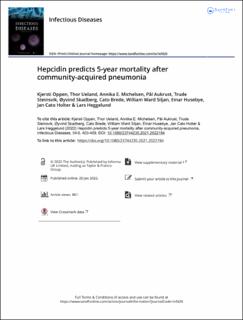Hepcidin predicts 5-year mortality after community-acquired pneumonia
Oppen, Kjersti; Ueland, Thor; Michelsen, Annika Elisabet; Aukrust, Pål; Steinsvik, Trude; Skadberg, Øyvind; Brede, Cato; Siljan, William Ward; Husebye, Einar; Holter, Jan Cato; Heggelund, Lars
Journal article, Peer reviewed
Published version

Åpne
Permanent lenke
https://hdl.handle.net/11250/2998861Utgivelsesdato
2022Metadata
Vis full innførselSamlinger
- Department of Clinical Science [2318]
- Registrations from Cristin [9791]
Sammendrag
Background
Virtually all living organisms, including microbes and humans, depend on iron to survive and grow. During an infection, the plasma level of iron and several iron-related proteins change substantially. We hypothesized that iron and iron-related proteins could predict short- and long-term outcomes in community-acquired pneumonia.
Methods
Blood samples from a prospective cohort of 267 in-patients with community-acquired pneumonia were analysed for hepcidin, ferritin, iron, transferrin, transferrin saturation, and soluble transferrin receptor at admission and 6-weeks post-discharge. Adverse short-term outcome was defined as admission to intensive care unit or death within 30 days, and long-term outcome was assessed as 5-year overall mortality. Logistic regression, Kaplan Meier survival curves, and Cox regression models with cut-offs at median for the potential biomarkers were used for statistical evaluation.
Results
Low admission levels of hepcidin predicted 5-year overall mortality, independently of age, sex, comorbid conditions, and anaemia. Low levels of ferritin at admission as well as low levels of iron and transferrin saturation and high levels of soluble transferrin receptor at the 6-week follow-up were predictors of 5-year overall mortality in univariable, but not in multivariable analyses. Neither of these potential biomarkers predicted adverse short-term outcomes.
Conclusions
In hospitalized patients with community-acquired pneumonia, low levels of hepcidin at admission predicted 5-year overall mortality, but not short-term adverse outcome.
